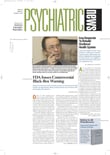About 20 percent of the 19.4 million American adults with a substance use disorder meet diagnostic criteria for at least one type of mood disorder, and about 18 percent of this group also meet criteria for an anxiety disorder.
A significant proportion of those diagnosed with a mood or anxiety disorder also turn out to have a substance use disorder, according to data from the 2001-02 National Epidemiologic Survey on Alcohol and Related Conditions (NESARC), which was conducted by the National Institute on Alcohol Abuse and Alcoholism (NIAAA).
The data from the survey appeared in the August Archives of General Psychiatry.
Of the 19.3 million adults estimated to have a mood disorder, almost 20 percent had a substance use disorder as well, and of the 23 million adults estimated to have an anxiety disorder, almost 15 percent had a substance use disorder.
“These results highlight the need for all individuals in treatment to be fully assessed for the presence or absence of a range of psychiatric disorder,” the authors stated.
Primary investigator Bridget Grant, Ph.D., used the NIAAA Alcohol Use Disorder and Associated Disabilities Interview Schedule–DSM-IV Version to detect drug and alcohol abuse and dependence, major depression, dysthymia, mania, hypomania, panic disorder with and without agoraphobia, social phobia, specific phobia, and generalized anxiety disorder.
Grant is chief of the Laboratory of Epidemiology and Biometry in NIAAA's Division of Intramural Clinical and Biological Research.
The sample used for the 2001-02 NESARC was based on the sampling frame of the U.S. Census 2000/2001 Supplemental Survey.
Approximately 1,800 lay interviewers with the U.S. Census Bureau administered the NIAAA Alcohol Use Disorder and Associated Disabilities Interview Schedule-DSM-IV Version to 43,093 adults aged 18 and older to assess the prevalence and co-morbidity of a number of mental illnesses.
Respondents also answered questions about whether they received treatment during the preceding year for drug and/or alcohol abuse or dependence, as well as for a mood or anxiety disorder.
Grant assessed whether respondents met criteria for independent or substance-induced mood and anxiety disorders during the year prior to the interview.
Respondents were classified as having an independent mood or anxiety disorder if none or only some of the episodes were induced by drugs or alcohol. They were classified as having a substance-induced disorder if all episodes of mood and anxiety were induced by drugs or alcohol over the prior year.
These were among the findings:
•
About 9.2 percent of the total sample—approximately 19.3 million adults—had an independent mood disorder, and 11.1 percent, or 23 million adults, had an anxiety disorder.
•
Of the 19.3 million adults with a mood disorder, an estimated 202,211 people (about 1 percent) experienced episodes that were classified as being exclusively substance induced. Of the 23 million with an anxiety disorder, an estimated 50,980 (about .02 percent) experienced substance-induced anxiety episodes.
•
Approximately 9.4 percent of the sample, or an estimated 19.4 million adults, were classified as having a substance use disorder. Almost 9 percent of Americans had an alcohol use disorder, and 2 percent had a drug use disorder.
•
Almost 26 percent of respondents with a mood disorder and 12.1 percent of those with an anxiety disorder sought treatment during the 12 months prior to the survey.
•
Of the estimated 1 million people with an alcohol use disorder who sought treatment, 40.7 percent had a mood disorder, 33 percent had an anxiety disorder, and 33 percent had a comorbid drug use disorder.
•
Of the estimated 550,000 people with a drug use disorder who sought treatment, about 60 percent had a mood disorder and 43 percent an anxiety disorder.
“We found a high prevalence of alcohol and drug use disorders among people who went to seek treatment for a mood or anxiety disorder and vice versa,” Grant told Psychiatric News.
She pointed out that a large majority of those disorders are independent.“ In the clinical literature, the general consensus in the past was that for those who were alcohol or drug dependent, nearly 60 percent of all mood and anxiety disorders, particularly mood disorders, were substance induced,” she said.
“However, we found a very small percentage of people who have substance-induced disorders—most of them are independent or what the DSM calls primary.”
Grant pointed out that when clinicians falsely assumed that mood or anxiety disorders were substance induced, patients would not receive treatment for their mood or anxiety disorder because it was believed that once the drinking or drug abuse stopped, the disorder would vanish.
The NESARC findings indicate that mood and anxiety disorders should be more thoroughly addressed by substance abuse treatment specialists, and substance use disorders better addressed by mental health and primary care clinicians, she said.
Arch Gen Psychiatry 2004 61 807
